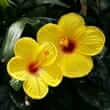Background
- The Hibiscus genus contains several species, many of which have been used medicinally. For instance, Hibiscus rosa-sinensis has been documented in the ancient Indian scriptures. Hibiscus sabdariffa has been used as a folk medicine in Canada, and appears promising in treatment of hypertension (high blood pressure). Hibiscus cannabinus has been studied to treat head lice, although there is currently insufficient available evidence in this area.
- Hibiscus sabdariffa and compounds isolated from it (for example, anthocyanins and hibiscus protocatechuic acid) are likely candidates for future studies. There is limited reported safety data about hibiscus, although it is popularly used as a tea.
- Based on ethnobotanical study, Hibiscus tiliaceus has been used throughout the Vanuatu archipelago to speed childbirth. Hibiscus sabdariffa L., has been used as a folk medicine in Canada. Hibiscus rosa-sinensis has been documented to have been used for several ailments in the ancient Indian scriptures.
References
Natural Standard developed the above evidence-based information based on a thorough systematic review of the available scientific articles. For comprehensive information about alternative and complementary therapies on the professional level, go to . Selected references are listed below.
- Ali BH, Al Wabel N, Blunden G. Phytochemical, pharmacological and toxicological aspects of Hibiscus sabdariffa L.: a review. Phytother Res 2005;19(5):369-375.
View Abstract - Brunold C, Deters A, Knoepfel-Sidler F, et al. Polysaccharides from Hibiscus sabdariffa flowers stimulate proliferation and differentiation of human keratinocytes. Planta Med. 2004;70(4):370-373.
View Abstract - Chang YC, Huang HP, Hsu JD, et al. Hibiscus anthocyanins rich extract-induced apoptotic cell death in human promyelocytic leukemia cells. Toxicol Appl Pharmacol 6-15-2005;205(3):201-212.
View Abstract - Chen JJ, Huang SY, Duh CY, et al. A new cytotoxic amide from the stem wood of Hibiscus tiliaceus. Planta Med 2006;72(10):935-938.
View Abstract - El Basheir ZM, Fouad MA. A preliminary pilot survey on head lice, pediculosis in Sharkia Governorate and treatment of lice with natural plant extracts. J.Egypt.Soc.Parasitol. 2002;32(3):725-736.
View Abstract - Frank T, Janssen M, Netzel M, et al. Pharmacokinetics of anthocyanidin-3-glycosides following consumption of Hibiscus sabdariffa L. extract. J Clin Pharmacol 2005;45(2):203-210.
View Abstract - Herrera-Arellano A, Flores-Romero S, Chavez-Soto MA, et al. Effectiveness and tolerability of a standardized extract from Hibiscus sabdariffa in patients with mild to moderate hypertension: a controlled and randomized clinical trial. Phytomedicine. 2004;11(5):375-382.
View Abstract - Hou DX, Tong X, Terahara N, et al. Delphinidin 3-sambubioside, a Hibiscus anthocyanin, induces apoptosis in human leukemia cells through reactive oxygen species-mediated mitochondrial pathway. Arch Biochem Biophys. 8-1-2005;440(1):101-109.
View Abstract - Kim MS, Kim JK, Kim HJ, et al. Hibiscus extract inhibits the lipid droplet accumulation and adipogenic transcription factors expression of 3T3-L1 preadipocytes. J.Altern.Complement Med. 2003;9(4):499-504.
View Abstract - Lin HH, Huang HP, Huang CC, et al. Hibiscus polyphenol-rich extract induces apoptosis in human gastric carcinoma cells via p53 phosphorylation and p38 MAPK/FasL cascade pathway. Mol Carcinog. 2005;43(2):86-99.
View Abstract - Muthu SE, Nandakumar S, Rao UA. The effect of methanolic extract of Tamarindus indica Linn. on the growth of clinical isolates of Burkholderia pseudomallei. Indian J Med Res 2005;122(6):525-528.
View Abstract - Tseng TH, Lee YJ. Evaluation of natural and synthetic compounds from East Asiatic folk medicinal plants on the mediation of cancer. Anticancer Agents Med Chem 2006;6(4):347-365.
View Abstract - Tseng TH, Kao TW, Chu CY, et al. Induction of apoptosis by hibiscus protocatechuic acid in human leukemia cells via reduction of retinoblastoma (RB) phosphorylation and Bcl-2 expression. Biochem.Pharmacol. 8-1-2000;60(3):307-315.
View Abstract - Varavithya V, Phongkitkarun S, Jatchavala J, et al. The efficacy of roselle (Hibicus sabdariffa Linn.) flower tea as oral negative contrast agent for MRCP study. J Med Assoc Thai 2005;88 Suppl 1:S35-S41.
View Abstract - Wu PL, Wu TS, He CX, et al. Constituents from the stems of Hibiscus taiwanensis. Chem Pharm Bull (Tokyo) 2005;53(1):56-59.
View Abstract







